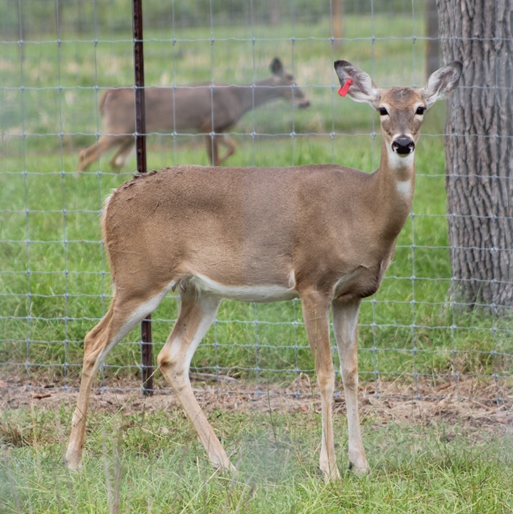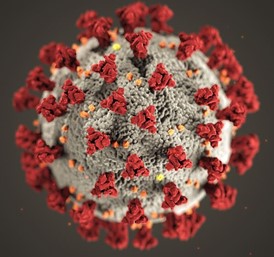Samantha M. Wisely, Extension Specialist for Wildlife Diseases, University of Florida
–
What are SARS-CoV-2 and COVID-19?
Sudden acute respiratory syndrome coronavirus 2, or SARS-CoV-2, is the virus responsible for the global pandemic that began in late 2019. While SARS-CoV-2 is the name of the virus, coronavirus disease 2019 or COVID-19, is the name of the disease it causes. Prior to the SARS-CoV-2 pandemic, another coronavirus, SARS-CoV-1, almost became a pandemic in 2003. Both viruses are zoonotic, meaning that they can jump between animal species and people.
SARS-CoV-2 is a member of the coronavirus family, which has hundreds of different virus species that cause respiratory and gastrointestinal disease in people, domestic species, and wildlife. Coronaviruses are responsible for a large proportion of common colds in people each winter, but other coronaviruses can cause severe illness, as we have seen with the global pandemic caused by SARS-CoV-2.
–
Can white-tailed deer get COVID-19?
Many coronaviruses can be transmitted across species, including the virus that causes COVID-19. Studies have shown that many mammals can become infected with SARS-CoV-2. There is growing evidence that people can transmit the virus to various species, including domestic cats, farmed mink, and dogs. Mink and cats are known to spread the virus within the species, for example from mink to mink. In some cases, like on mink farms, people have become infected from mink. Vaccines are being developed for multiple animal species to slow or prevent transmission of the virus from animal to animal or from animals to people.

Molecular epidemiological analysis of deer and people in Ohio demonstrated transmission from people to deer and from deer to deer in the wild. Credit: Dr. Juan Campos Krauer
Recently, a series of studies has demonstrated that white-tailed deer can become infected with SARS-CoV-2. Experimental infection of white-tailed deer with SARS-CoV-2 demonstrated that white-tailed deer are highly susceptible to infection, but they do not show signs of illness. Deer-to-deer transmission has been demonstrated experimentally.
Studies have shown that wild white-tailed deer can also become infected. In northeast Ohio from January to March 2021, hunter-harvested deer had a SARS-CoV-2 infection prevalence of 35%. The genetic variant of the virus was the same as the variant that was peaking in people in northeast Ohio at the same time. Molecular epidemiological analysis of deer and people demonstrated transmission from people to deer and from deer to deer in the wild. Deer populations that were closest to urban centers had the highest prevalence of infection, but the exact mechanism of transmission is unknown. While respiratory aerosols are the most common route of exposure, contaminated wastewater has also been speculated as a route for people to pass the virus to deer. It appears that wild white-tailed deer have been exposed to the virus in multiple parts of the United States. Deer from Illinois, Michigan, Pennsylvania, and New York had antibodies to SARS-CoV-2, which suggests they were exposed to the virus. Since the first discovery of the virus in deer, routine pathogen surveillance of white-tailed deer in Oklahoma and Quebec, Canada, have found the virus in wild white-tailed deer.
–
Can people get COVID-19 from deer?
As of January 2022, viral transmission from deer to people has not been demonstrated. Although this virus has previously been demonstrated to jump from various animal species to people, the risk to most people is very low. According to the Centers for Disease Control and Prevention COVID-19 guidelines, there are 3 categories of risk for people to contract COVID-19 from wildlife depending on their behavior or occupation.
–
1) The general public:
Most people fall into this category. General precautions should be taken for deer as for all wildlife.
-
- Always keep a safe distance between yourself and wildlife.
- Do not feed wildlife or touch wildlife droppings.
- Keep pets away from wildlife.
- Always wash your hands after playing or working outside.
- Never handle dead or sick animals; contact your state wildlife agency instead.
- Leave young animals alone. Parents are often hiding close by.
–
2) Hunters:
There is no evidence that people can contract COVID-19 from harvested deer meat, either while preparing or eating it. Hunters should always follow these best management practices to avoid getting sick from wildlife:
-
- Do not allow contact between wildlife and pets or hunting dogs.
- Do not harvest animals that appear sick or are found dead.
- Keep game meat cool and clean.
- When field dressing game meat:
-
- Wear gloves.
- Do not eat, drink or smoke.
- Avoid cutting through the backbone and spinal tissues; avoid eating the brain.
- Wash your hands, cutting surfaces and cutting utensils thoroughly when you are finished.
- Consider wearing a mask if you are at an elevated risk for complications from COVID-19.
-
- Cook your meat thoroughly (an internal temperature of 165°F or higher).
–
3) Deer farmers and wildlife professionals who will be in close proximity to white-tailed deer:
Activities that bring you in close contact with live animals increase your risk of contracting COVID-19 via respiratory aerosols. If you are in close contact with white-tailed deer, and/or if you are at an elevated risk for complications due to COVID-19, consider the following precautions:
-
- Get vaccinated and/or boosted against COVID-19.
- Wear a mask, eye protection and gloves when handling live deer.
–
For the latest information on CDC guidelines for COVID-19 in wildlife, use the following link:
Reducing the Risk of SARS-CoV-2 Spreading between People and Wildlife
–
For a pdf version of this peer-reviewed publication, that includes references to the scientific literature please visit:
Facts about Wildlife Diseases: SARS-CoV-2 in White-Tailed Deer
- How Landowners Can Help Gopher Tortoise Conservation in the Florida Panhandle - August 29, 2025
- Armadillo Biology, Management, and Disease in the Panhandle - February 21, 2025
- Crop Damage from Deer in the Panhandle - August 15, 2024

